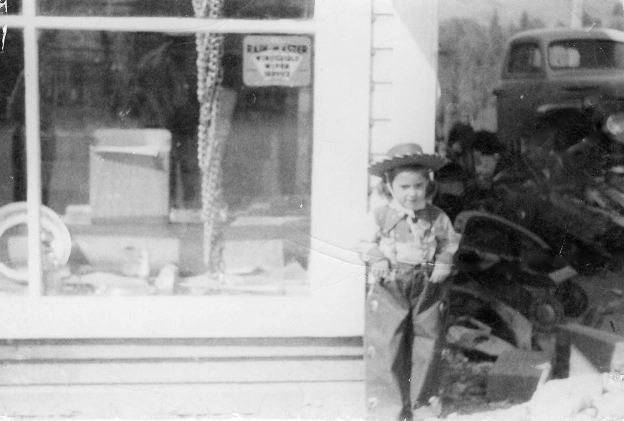
My grandmother was often convinced she was Mamie Eisenhower.
We couldn’t call her by her real name, in case it sent her over the edge. I remember driving up to the back of the building on the top of the hill—every time it was around Christmas. We’d buzz—then the door would buzz and click unlocked. We’d push the industrial steel door open and wind our way up the long ramp to the second door, our footsteps echoing on the polished tile floors. Then we buzz again and a nurse would open the second floor door.
I always tried not to look too closely at the grey-faced patients that crowded around the door to inspect the visitors. Kept my eyes down. I can still taste the smell—stale urine and stagnant air. The cheerful nurses would usher us into my grandma’s room. None of us took our coats off. She’d shuffle in most times without her dentures in and immediately start saying, “You’re not my daughter,” to my mom, while my mom handed her Christmas presents, pajamas, slippers, new panties and maybe some candy. Then we’d all sit there while grandma kept on reminding my mom that she wasn’t actually her daughter, and my mom would struggle to smile.
Our visits were normally pretty short. We’d all get back in the car and continue on with whatever was next on the day’s agenda.
My grandma had been hospitalized, due to schizophrenia, pretty much full-time since my mom was about six. I heard romantic stories of my grandfather driving hours down to Seattle from the interior of BC in search of a doctor that could cure her. He had broad shoulders, thick black eyebrows, a strong nose and square jaw. In pictures she looked fragile, with full lips and dark tentative eyes.
When I was in my early 20s, I visited my grandmother alone—didn’t tell my parents. We sat facing each other in the lounge area—not her room—in vinyl chairs, under fluorescent overhead lighting, the smell of overcooked hospital food lurking in the room.
“You look very beautiful today,” I said.
“Oh, thank you,” she smiled with her whole face exposing her toothless gums and smoothed her wild white hair down, her eyes alive for a moment.
“Who are you?” she asked.
“I’m your granddaughter, Jane. Wendy’s daughter,” I replied.
“Wendy’s Barbara and Henry’s daughter,” she implored.
“Okay, Grandma,” I said gently.
I took her left hand and sandwiched it between mine. I felt her warm, papery thin, age-spot riddled skin. It was the first time I had ever touched her. I looked up from studying her hand and stole a glimpse of the woman who once held me as an egg in my mother’s belly. Half of me was once in her—crazy thought.
“Who are you?” she asked again. “Wendy is Barb and Henry’s daughter.”
“I just want you to know I love you,” I said, and then I got up and left. I thanked a nurse on the way out.
That was the last time I saw her.
I often wondered how my mom could look so unaffected during and after those annual visits. How incredibly painful it must be to not be seen and recognized by your own mother. That type of pain is hard to acknowledge, and when suppressed, it can distort the person it is engulfing—forcing a numbing out of feeling in order to keep functioning.
I know my grandmother suffered severe psychological trauma earlier in life. It never loosened its grip. As trauma does, it imprinted itself on my mom as well. My mom has done her very best with what she was given in this life, but—to a much lesser degree—she has only been able to see fragments of me. Being unable to face our own pain and see ourselves clearly can make it almost impossible to see others clearly.
Every child desperately wants to be seen by her mother—strength and flaws—fully and completely. Being seen makes us feel real. It helps us form a stable sense of self. This need to be seen can be unquenchable if we didn’t have it as a child.
To stop the cycle of trauma—after it’s left its print on our neurobiology, physiology and our hearts—we need the courage of a peaceful warrior to face our pain, withstand it and then integrate it into who we are. Not to push it away, but to look at ourselves in a way that our parents might have been unable.
We need therapists, healers or other people we connect with intimately, to see us fully and accurately reflect back who we are while we connect with them. I know I’m making mistakes with my daughter, but she also feels seen, acknowledged and validated.
Past trauma isn’t a life sentence.
We can harness it, integrate it and transform our experiences into post traumatic growth.
.
Relephant:
The Rescue: Quieting & Healing our Parts—The Critic, Caretaker, Abandoned Child & 6 Others.
Author: Jane Clapp
Editor: Yoli Ramazzina
Photo: Author’s own.
 Share on bsky
Share on bsky




Read 0 comments and reply